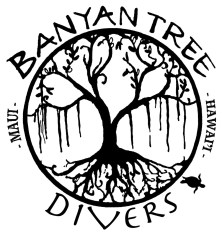Maui Fish Guide

Snorkeling and scuba diving in Maui are a must for your bucket list, especially if you’re planning to visit the beaches of Lahaina. When you enter the ocean here, you can encounter beautiful tropical fish, Hawaiian green turtles, and even sharks. To enhance your diving or snorkeling experience, consider learning about the marine life you might see. Banyan Tree Divers Maui has created a practical Maui Scuba Diving Fish Guide, which includes photos and fascinating information about the unique sea life that inhabits Maui’s coral reefs and coastline.
Maui Fish
Malamalama
Commersonʻs Frogfish

A female frogfish perched on coral at Mala Wharf in Lahaina, Maui.
Another master of camouflage is the frogfish. Experienced divers are always on the hunt for these truly alien-like creatures. Frogfish have soft, textured bodies that resemble a piece of coral or sponge, as they can change colors to match their surroundings. So, you can find frogfish in many colors, such as yellow, brown, orange, and black. Frogfish opportunistically attract unsuspecting organisms with a unique appendage that acts like a fishing lure. While sometimes rare, you can find them at every Kaanapali and Lahaina scuba diving location!
Nohu
Scorpionfish
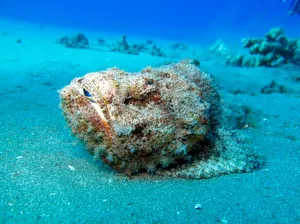
A scorpionfish sitting on the sand at Airport Beach in Kaanapali, Maui.
The winner of camouflage goes to the Scorpionfish. They are nearly impossible to spot since they resemble the rocks they perch on top of. Scorpionfish are rated as one of the most poisonous creatures in the animal kingdom and are the perfect reason not to touch anything underwater. Their spines contain a venomous mucus that is fatal to other animals but only extremely painful for humans.
Ulae
Lizardfish
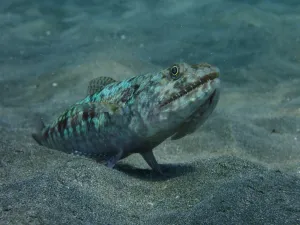
Kaʻanapali, Maui, Hawaiʻi
The lizardfish’s cream and brown colors blend well with the sandy ocean floor. They often bury themselves in the sand with their eyes exposed and can attack prey from up to 6 feet away! You can find fourteen of the 50 species of lizardfish in the Hawaiian Islands.
Pakʻiʻi
Flounder

Kaʻanapali, Maui, Hawaiʻi
This recognizable member of the flatfish family looks just like it sounds. Juvenile flounders look like regular fish with eyes on either side of their bodies. As they mature, one eye slowly drifts to the other side of the head. Thus, the adult flounder has two eyes facing upward that can rotate in any direction.
Hinimanu
Spotted Eagle Ray
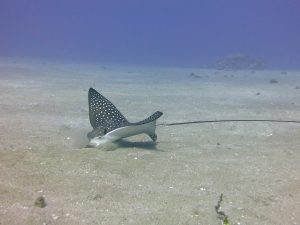
Kaʻanapali, Maui, Hawaiʻi
This graceful member of the Eagle Ray family tends to prefer ocean temperatures of 75-81 degrees Fahrenheit, making Hawaiʻi an attractive area for frequent visits. Their lateral diamond-shaped bodies include several venomous barbs at the base of their long tails, and they have beautiful white dots on their heads and wings. Due to overfishing, they have been listed on the IUCN Red List as Near Threatened, primarily in Southeast Asia and Africa.
They forage in the sandy bottom for crustaceans and mollusks. Their predators are mainly sharks. Since the females give birth to live pups, sharks follow pregnant females and feed on the newly born eagle ray pups.
Manō
White-tip Reef Shark

Mala Wharf, Lahaina, Maui
White-tip reef sharks are the most commonly sighted on shallow reefs around Maui. They are generally harmless to divers because their diet consists of small fish, octopuses, and crustaceans. Unlike other sharks, which must constantly swim to breathe, White-tip Reef Sharks can pump water across their gills, allowing them to rest on the bottom during the day.
White-tip reef Sharks like to hide in caves or crevices and typically return to the same shelters for months or even years. Their loyalty to certain areas inspired the Hawaiian belief in ʻaumākua, the spirits of family ancestors who take animal form and protect their descendants.
Their susceptibility to overfishing, coupled with a slow reproductive rate, has led to the IUCN listing them as Vulnerable. Hawaiʻi recently outlawed catching, harming, or killing sharks in state waters. If adequately regulated, this will help maintain their populations.
Kikakapu
Ornate Butterflyfish

Ornate Butterflyfish, Kaʻanapali, Maui, Hawaiʻi
The Ornate Butterflyfish is one of the most photogenic fish in Maui. Its bright, contrasting colors protect it from predators and make for excellent photos. Adults are predominantly found in pairs and stay together for life, earning it the title of the most romantic fish you can see snorkeling or diving in Lahaina.
These fish feed exclusively on coral polyp tissue and avoid corals with seaweed growth. Thus, they are susceptible to starvation in coral colonies that experience heavy algae growth during changes in water temperature and nutrient levels.
Kikakapu Kapuhili
Raccoon Butterflyfish
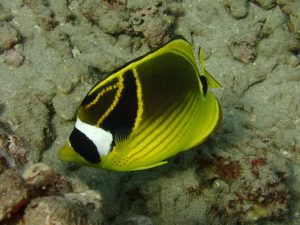
Black Rock, Kaʻanapali, Maui
We attribute the name Raccoon Butterflyfish to the black patches around its eyes, which resemble those of a raccoon. These nocturnal fish feed primarily on nudibranchs and small invertebrates. You will find them in small schools feeding on algae and coral polyps during the day.
Lau Hau
Threadfin Butterflyfish
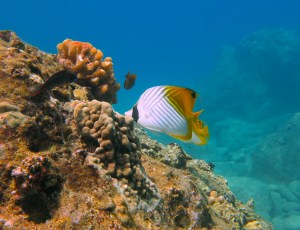
Kapalua Bay, Maui, Hawaiʻi
Threadfin butterflyfish have a wide distribution throughout the Indo-Pacific region. Unlike their counterparts in the Red Sea, those found in Hawaiʻi have a black spot on their dorsal fins. They tend to hide more than the ornate Butterflyfish and are thus more challenging to spot without inspecting underneath the coral.
Lau Wiliwili-nukunuku-oioi
Yellow Longnose Butterflyfish

Mala Wharf, Lahaina, Maui
The yellow longnose Butterflyfish is very territorial. These monogamous fish aggressively defend their territory by chasing out intruders. Males chase males, and females chase females. Males keep other males from their mates, and females block other females from their food source. They are not monogamous, but they do not need to co-parent, as they lay free-floating eggs. However, their teamwork significantly increases their survival. You find heterosexual pairs swimming together for up to several years or more.
Kika Kapulauhau
Teardrop Butterflyfish
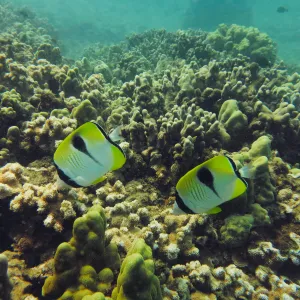
Kapalua Bay, Maui, Hawaiʻi
These beautifully painted fish feature a black upside-down teardrop on their flanks! Teardrop Butterflyfish reach a maximum length of 7.9 inches (20 centimeters). Like other species of Butterflyfish, they are monogamous. You can observe these fish in shallow coral reefs and lagoons. They feed on both soft and hard corals, as well as small crustaceans and filamentous algae.
Lau Hau
Bluestripe Butterflyfish
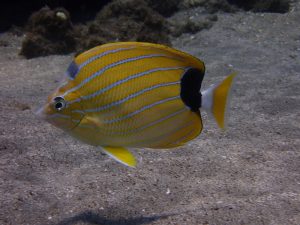
Kaʻanapali, Maui, Hawaiʻi
This particular species is rare and only found in the Hawaiian Islands! It commonly inhabits shallow reef areas, although you can also see the Bluestrip Butterflyfish at depths of up to 600 feet. The horizontal blue lines along its yellow body make it distinctive. These omnivorous fish require resource-rich environments where food is readily available. Thus, males of this species operate a harem system, defending territory that includes up to four smaller females.
Lau Hau
Four Spot Butterflyfish

Mala Wharf, Lahaina, Maui
This fish’s name comes from the two white spots near its dorsal fin and tail on either side of its body. Four spots feed exclusively on hard corals, and their abundance in a reef system is an excellent indicator of reef health. Recent global changes in climate, especially the beaching events of 2015-2016 due to rising ocean temperatures, have caused noticeable changes in the Fourspot’s reproduction rates.
Lau Hau
Rainbow Butterflyfish
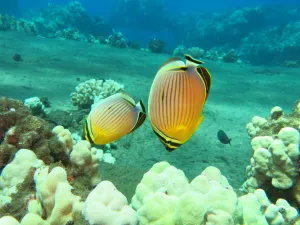
Mala Wharf, Lahaina, Maui
As its name suggests, the rainbow butterflyfish is among the most colorful in the butterfly family. We often see these beauties at Mala Pier in Lahaina. Their attractive stripe pattern, contrasted by jet-black lines, makes them some of the most enticing to photograph.
Lau Wiliwili
Lemon “Milletseed” Butterflyfish

Lemon Milletseed Butterflyfish in Kaanapali, Hawaii
This small yellow fish has tiny black spots along its flank in a vertical pattern. Although common in Hawaiʻi, you only find this fish in Hawaiʻi! Twenty-five percent of Hawaiʻi’s reef fishes are endemic to the islands! That is an enormous number and part of what makes diving in Hawaii unique. You find Butterflyfish at depths of 800-plus feet.
This schooling Butterflyfish species lives in the water column and feeds on zooplankton. It breeds between January and May, and you find juveniles along shallow West Maui coral reefs between April and June!
Potter’s Angelfish
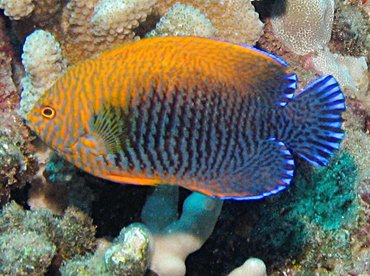
Male Potter’s Angelfish in Lahaina, Hawaii
Potter’s Angelfish is another example of a species native only to the Hawaiian Islands. They are rare to see because of their shy nature. A Male Potter’s Angelfish has bright orange and blue colors! This coloration makes them a favorite among avid scuba divers and snorkelers on Maui. They spend much of their time at “cleaning stations” where they eat algae from the shells of Hawaiian Green Turtles.
Lolo
Yellowtail Wrasse

Maui, Hawaiʻi
This wrasse is strong and can push rocks and coral over to find food beneath. With two prominent teeth in the upper jaw, the Lolo eats snails, hermit crabs, sea urchins, shrimps, and mollusks. They bury themselves in the sand at night. Scuba divers and snorkelers can find Yellowtail Wrasse in shallow Mauiauin coral reefs.
Hinalea Lauwili
Saddle Wrasse

Maui Hawaiʻi
The saddle wrasse is the most abundant reef fish in the Hawaiian Islands due to its extraordinary ability to change sexes. Its name comes from the red stripe, or “saddle,” that extends around its body behind its pectoral fin.
There are 43 fish in the wrasse family, and 13 are native to Hawaii. At Kahekili Beach Park or Airport Beach in Kaanapali, a long-time resident saddle wrasse circles our legs, searching for food that lifts out of the sand while we practice our dive skills.
Lolo
Juvenile Yellowtail Wrasse
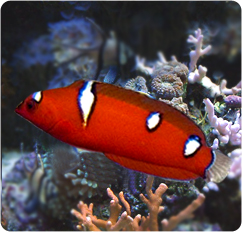
Often mistaken for Nemo, this juvenile wrasse has a bright orange-red body with white spots. Interestingly, whenever female juvenile wrasses become overrepresented in their respective groups, some of them change their sex to male.
Kihi Kihi
Pennantfish or Bannerfish
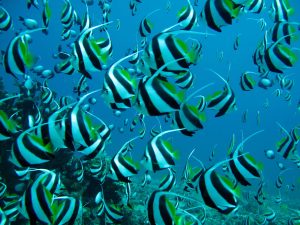
Kahekili Beach Park, Kaʻanapali, Maui
These schooling fish are found in the water column, feeding on plankton. You see Bannerfish eating algae from turtles’ backs! They are easily mistaken for the Moorish idol, which we highlight next. So, Bannerfish is sometimes called a false Moorish Idol.
Kihi Kihi
Moorish Idol

Kahekili Beach Park, Kaanpali, Maui
Often recognized as the fish from Finding Nemo, this distinct species has beautiful yellow, white, and black markings and an extended dorsal fin. It can grow an impressive 10 inches in length; the older it gets, the less prominent its dorsal fin becomes. In adulthood, you find this Maui fish alone.
The name Moorish Idol comes from the Moors of Africa, who believed the Moorish Idol fish could bring happiness to one’s life! Although popular in the aquarium trade, this fish species has difficulty adjusting to life in captivity. Moorish Idols are picky yet voracious eaters and can become destructive!
Hinalea
Rainbow Cleaner Wrasse

Maui, Hawaiʻi
The endemic Hawaiian rainbow cleaner wrasse is famous for its cleaning services. It populates territories called “cleaning stations,” where larger animals congregate to have parasites, loose skin flakes, and mucus removed from their bodies. You can see this wrasse cleaning the gills and teeth of much larger fish and eels, or earwax from a human’s ear!
Hinalea I Iwi
Bird Wrasse
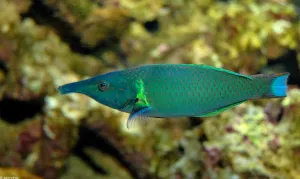
Maui, Hawaiʻi
The bird wrasse might be the easiest fish to identify with the male’s deep blue and green coloration. Females tend to be browner. Its prominent snout allows it to dig for prey and break it into small pieces. Like other wrasses, they can change sexes to adapt to the breeding environment.
Manini
Convict Tang
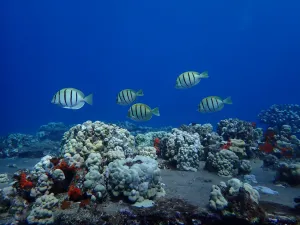
Mala Wharf, Lahaina, Maui
Convict tangs are members of the Surgeonfish family. You find this schooling fish widely found along shallow reefs in Hawaiʻi. They are herbivores who spend much of their day grazing on seaweed. These algae feeders play a crucial role in maintaining reef health. They stifle the growth of fast-growing algae, which have the potential to choke the reef if left unchecked.
Manini was a significant food source for early Hawaiians. In modern Hawaiian slang, Manini can mean “no big thing.”
Lauʻipala
Yellow Tang
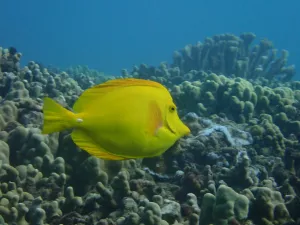
Kaʻanapali, Maui, Hawaiʻi
These brightly colored yellow fishes are perhaps some of the most recognizable Hawaiʻi reef fishes. Like the Convict tang, Yellow tangs are members of the Surgeonfish family. They use blades at the end of their tails for defense to ward off competitors from feeding in their territory.
Yellow tangs are a popular fish choice for the aquarium trade. As of 2021, Hawaii banned the collection of aquarium fish pending a further environmental review. This controversial dispute is ongoing.
Uhu
Parrotfish
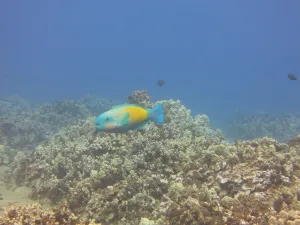
Kaʻnapali, Maui, Hawaiʻi
These easily recognizable fish are common inhabitants of shallow reefs. You can distinguish Parrotfish males by their brightly colored blue, green, pink, and yellow. Their sharp front teeth graze on delicate seaweeds that grow on rocks and dead corals. Indeed, Parrotfish bite off chunks of coral and convert those pieces into fine sand. Estimates indicate that large Parrotfish produce as much as one ton of sand per year, making this species crucial to sand production and the maintenance of coral reef health.
Nunu
Trumpetfish

Mala Wharf, Lahaina, Maui
It is easy to see where the trumpetfish gets its name. Their long bodies stalk the coral bed and stealthy attack prey by widening their jaws and sucking the victim up into their almost transparent bodies. The Nunu sometimes follow schools of surgeonfish feeding on tiny organisms forced from cover as they graze along the reef.
Kala
Bluespine Unicornfish
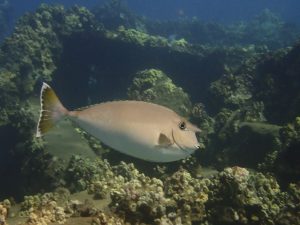
Mala Wharf, Lahaina, Maui
Bluespine unicorn fish are common tangs. They have blueish-grey bodies with blue spines on each side of the base of their tails. A short, bony horn protrudes from their forehead, hence their name. They can grow up to 27 inches in length.
Kala was a significant food source in ancient Hawaiʻi. Hawaiians could also make a small knee drum by stretching the kalaʻs tough skin over half a coconut.
Umauma Lei
Orangespine Surgeonfish

Maui, Hawaiʻi
The Orangespine is another surgeonfish that is intrinsic to the health of Hawaiʻi’s shallow reefs. It grazes on algae, keeping them from getting out of control. Its grey bodies boast two orange spines on either side of the base of its tails and yellow coloring on its face.
Humuhumunukunukuapua’a
Rectangular Triggerfish
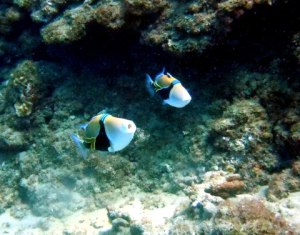
Black Rock, Kaʻanapali, Maui
This solitary Triggerfish is the Hawaiʻi state fish! The Rectangular Triggerfish has a famously long Hawaiian name, which you might overhear at the beach during your visit to Maui. Rectangular Triggerfish are plentiful and a common sighting for snorkelers and scuba divers in Maui. The aggressive-minded fish spends its day digging for invertebrates buried in the sand. They chase other fish out of their territory or sometimes flee a predator by making grunting noises to warn other Triggerfish. They are incredibly aggressive when guarding eggs.
Humuhumunukunukuapua’a
Picasso Triggerfish

Maui, Hawaiʻi
While not dangerous, the Picasso Triggerfish can appear quite aggressive. It is known to chase scuba divers and snorkelers when guarding its nest. Although they are small and unlikely to do any harm, you should try to keep a distance. We often spot these beautifully colored fish at Airport Beach and Black Rock in Kaanapali.
Alo’ilo’i
Hawaiian Damselfish
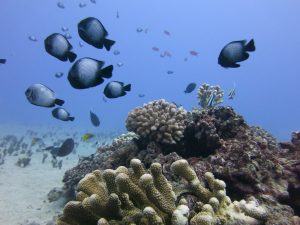
Kaʻanapali, Maui, Hawaiʻi
Endemic Hawaiian Damselfish look about the size of your fist. These fish can often be seen swelling in and out of cauliflower corals as juveniles and actively defending more significant swathes of the reef as adults. They are foragers yet territorial and make distinct clicking noises when threatened. They will even dart at your hand or mask! Have no fear, they are no bigger than 5 inches (12.5 cm). Males provide sole care for their offspring, unlike most animals. The female Damselfish guards the territory where they grew up.
Humuhumuhiʻukole
Pinktail Triggerfish

You can find these beauties swimming in shallow water. Pinktail Triggerfish grow up to 16 inches long. They are one of the largest species of Triggerfish!
Honu
Hawaiian Green Turtle

Mala Wharf, Lahaina, Maui
Maui is home to some of the Hawaiian green turtles’ most significant nesting grounds. Once endangered, turtle populations have recently made a considerable comeback. They can reach lengths of up to 4 feet and weigh over 300 pounds. Of the seven types of sea turtles, the Hawaiian green turtle (native to Hawaii) is the most common.
Turtles must breathe surface air, but can hold their breath for up to five hours! Though their eyesight is excellent underwater, they are nearsighted above water and on land.
The Hawaiian green turtle does not reach sexual maturity until 20, with some turning 40 before mating for the first time! Males grow long, thick tails, while females’ tails remain short.
Every two years, turtles travel nearly 600 miles to lay their eggs. The mother lays 75-100 eggs per nest in the sand away from the tide line, and she can dig as many as six nests. Turtles lay eggs in the early summer months because the temperature of the sand determines sex. The cooler the sand, the more males will hatch. Their eggs take two months to hatch.
Early life is hard for turtles. NOAA estimates that 1 in 1,000 to 1 in 10,000 individuals will reach adulthood. Interestingly, young turtles return to their original coastal habitat after spending 5 to 10 years in the open ocean. Their life span is estimated to be 50-150 years.
Puhi
White Mouth Moray Eel
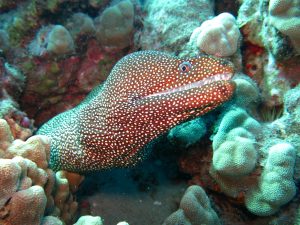
Kaʻanapali, Maui, Hawaiʻi
White Mouth Moray Eels reach up to lengths of 4 feet in Hawaiʻi, although they can grow longer in other parts of the world. We occasionally see eels hunting in tandem with the invasive peacock grouper. The pairing is the only known cooperative hunting by any species of fish.
These stunning moray eels are nocturnal hunters. Their excellent sense of smell makes up for their poor eyesight. They have two jaws! The second set of jaws pulls prey toward their stomachs. While not inherently dangerous, getting too close could invite a quick lashing out from these cautious critters.
He’e Mauli
Day Octopus

Mala Wharf, Lahaina, Maui
If you see an octopus out hunting, prepare for a delightful spectacle. Octopuses have mastered the art of disguise and can change their color and texture depending on their surroundings. Their lithe bodies and arms allow them to fit through tight spaces. The only complex structure they contain is a beak with a highly sharp-toothed tongue that octopuses use to pick apart crustaceans and small fish.
Though they see only black and white, they rapidly focus their eyes at different depths, taking in light from multiple directions. Therefore, they may be able to distinguish colors despite being colorblind!
A Hawaiian saying in the 19th century said:
Pua ke kō, kū mai ka heʻe
When the sugarcane flowers, the octopus appears
Sugar cane had been a staple crop of the Hawaiian Islands, and the cane blooms in November, when many believe octopuses are more abundant in the reef.
Ula
Spiny Lobster

Kahekili Beach Park, Kaanapali, Hawaii
Spiny lobsters are much smaller than the lobsters that initially come to mind. You find three species of spiny lobster in Hawaii. They can be hard to find because they like to hide during the day. Although they have been a delicacy in Hawaiʻi for many years, declining numbers have made them off-limits to commercial fishing.
Ula-Papapa
Slipper Lobster
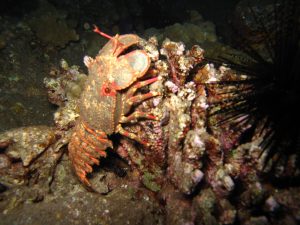
Mala Wharf, Lahaina, Maui
Slipper Lobsters in Hawaiʻi lack large claws and reach about 7 inches. Referred to as the “insects of the ocean,” slipper lobsters donʻt discriminate in their food s,ource only when they eat. This lobster species forages for food at night. They can grow as long as 20 inches in other parts of the world.
Final Thought About Maui’s Fish
We hope you enjoyed our guide to Maui’s fish. Scuba diving in Maui is a truly memorable experience, and it becomes even more enjoyable when you know what you are looking at!
Certified divers can take the PADI Advanced Diver course to select a dive focused solely on fish identification and reef ecology. All scuba divers can purchase a photography package that highlights the beautiful fish they see while diving in Maui.
